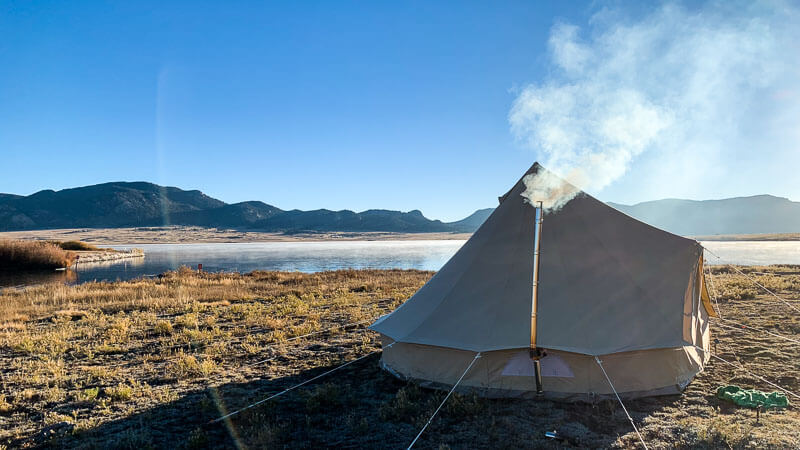Camping is one of the most common hobbies when it comes to outdoor activities.
And among the main benefits of this lifestyle is its versatility. After all, you can go on a trip any time of the year, whether it’s summer, spring, fall or winter. The only thing to decide is to get a suitable tent that will keep you warm and comfortable no matter the weather.
Today, you can easily and quickly get everything you need in camping stores: from equipment and waterproof clothes to well-protected shelters and wood stoves. And let’s talk about tent stoves more.
While modern camping stoves are safe and made specifically for inside tent use, it’s always worth learning a little more to avoid making mistakes.
Understanding how to use your stove properly and what not to do will help make your camping trip safe and successful.
Therefore, let’s take a closer look at the four most common stove mistakes some campers make.
Low-Quality Stove
One of the most common mistakes is choosing the wrong or low-quality stove.
Since some travelers can often be more concerned with choosing a tent or planning a trip, they may buy a stove that either is not suitable enough for their particular occasion or is of poor quality.
Therefore, find out more about what models are on the market before heading to the store, read reviews and compare options that interest you with your budget. It is best to avoid buying extremely cheap stoves, as their poor build quality or materials can carry health risks.
While in the store, feel free to ask questions and describe your needs to the consultant. After all, stoves are different: some may be ideal for small tents but not powerful enough for large shelters. Also, stoves can have different heat dissipation, so this is also worth considering, especially if you go camping in extreme conditions.
So, choose the stove that suits your needs and performance expectations. And avoid buying ultra-cheap models.
Wrong Placement
Today you can find tents with stoves or buy a stove separately.
In the first case, the stove already has its place in the tent to ensure good heating and safety. Here you should also read the instructions to learn more about how your stove works, how to use it correctly, and what not to do.
At the same time, if you buy a stove separately, you may need some time to figure out where it is worth placing it. The same issue can happen with tents that come with pre-installed stove jacks, as some manufacturers may not pay enough attention to this.
Where to place the stove best depends on its type, as well as the temperature you want to reach.
For example, to heat the tent to 65 degrees, place the glamping stove closer to the side wall of the tent. If it’s a cylinder stove, then this approach may not be sufficient to heat the tent because the heat comes straight up the flue pipe in such a stove. Therefore, it is better to place the stove closer to the tent’s center in this case.
The best options for placing the stove for the greatest efficiency and convenience are closer to the edge of the tent and at the door.
Compatibility Issue
Another common issue is compatibility. Your stove and tent must fit together. This is necessary for both safety and heating efficiency.
Therefore, ask a consultant about compatibility or recommendations when buying a stove. Moreover, you can also contact the manufacturer of the tent or stove. This will give you more information, and also you can get some advice, as many all-weather tent manufacturers often either make a ready-made tent + stove set or sell stoves separately.
When choosing a stove, you also need to consider the type of shelter you have since the more space inside the tent, the more heat it will need to raise the temperature.
Conical, tipi and dome tents heat up the fastest. Straight-wall and cabin tents take longer to warm up due to their shape and extra headroom.
Therefore, if you are going to buy both a tent and a stove, then you should consider your needs and preferences first of all. In other words, if your comfort in a tent depends more on the temperature than on the space inside, then cone or dome tents are your best bet. If you need extra space above your head, then it is better to take a straight-wall tent and a powerful stove.
Pipe Issue
This problem may arise directly with prolonged use of the stove.
One of the most common scenarios is a clogged pipe, so it’s critical to check if everything is in order from time to time and clean it from the buildup of waste and soot.
If you ignore the care of the stove, you may face issues such as the effect of a cold stove or a smoky tent (when the smoke does not exit the chimney normally or returns to the tent when the wind blows). This problem can also occur due to poor drafting. Therefore, when installing the stove, it is also recommended to check that everything is tightly attached since even small gaps can lead to improper pipe functioning.
In addition to unpleasant effects, such as a cold tent or a smoky tent, it also has health risks since carbon monoxide is released during the combustion process, which is extremely dangerous. That is why you should always pay attention to whether your stove is working properly and whether you need to clean the pipe before you go on a trip.

